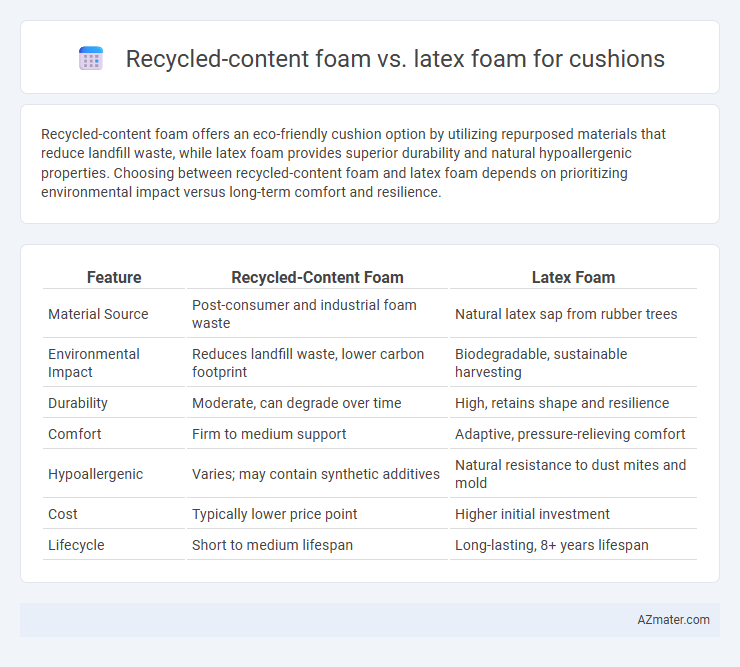Recycled-content foam offers an eco-friendly cushion option by utilizing repurposed materials that reduce landfill waste, while latex foam provides superior durability and natural hypoallergenic properties. Choosing between recycled-content foam and latex foam depends on prioritizing environmental impact versus long-term comfort and resilience.
Table of Comparison
| Feature | Recycled-Content Foam | Latex Foam |
|---|---|---|
| Material Source | Post-consumer and industrial foam waste | Natural latex sap from rubber trees |
| Environmental Impact | Reduces landfill waste, lower carbon footprint | Biodegradable, sustainable harvesting |
| Durability | Moderate, can degrade over time | High, retains shape and resilience |
| Comfort | Firm to medium support | Adaptive, pressure-relieving comfort |
| Hypoallergenic | Varies; may contain synthetic additives | Natural resistance to dust mites and mold |
| Cost | Typically lower price point | Higher initial investment |
| Lifecycle | Short to medium lifespan | Long-lasting, 8+ years lifespan |
Introduction to Cushion Foam Materials
Recycled-content foam offers an eco-friendly alternative by incorporating post-consumer or post-industrial materials, reducing environmental impact while maintaining durability and comfort in cushions. Latex foam, derived from natural rubber or synthetic sources, provides superior elasticity, resilience, and hypoallergenic properties, making it ideal for high-performance cushioning. Both materials differ in density, breathability, and longevity, influencing their suitability for various cushion applications.
What is Recycled-Content Foam?
Recycled-content foam for cushions is made by incorporating post-consumer or post-industrial foam waste into new foam production, reducing environmental impact by diverting materials from landfills. This foam maintains comparable comfort and durability to traditional foam while offering an eco-friendly alternative with a lower carbon footprint. Popular in sustainable furniture manufacturing, recycled-content foam often contains a blend of polyurethane and other recycled materials tailored for cushioning applications.
Understanding Latex Foam: Natural and Synthetic Varieties
Latex foam, derived from both natural rubber from Hevea brasiliensis trees and synthetic polymers like styrene-butadiene rubber, offers superior resilience and durability in cushions compared to recycled-content foam. Natural latex foam provides hypoallergenic properties, breathability, and eco-friendly benefits, while synthetic latex enhances consistency and resistance to wear. Choosing between these varieties depends on preferences for sustainability, comfort, and long-term performance in cushioning applications.
Environmental Impact: Recycled vs. Latex Foam
Recycled-content foam significantly reduces environmental impact by diverting waste from landfills and lowering carbon emissions through the reuse of existing materials. Latex foam, while natural and biodegradable, often involves intensive harvesting of rubber tree sap, which can lead to deforestation and resource depletion if not sourced sustainably. Choosing recycled-content foam supports circular economy principles, whereas responsibly sourced latex foam offers renewable benefits with cautious attention to ecological balance.
Comfort and Support Comparison
Recycled-content foam offers moderate comfort and support with its dense structure that retains shape over time, making it an eco-friendly option for cushions. Latex foam provides superior responsiveness and pressure relief due to its natural elasticity, enhancing overall comfort and spinal alignment. Both materials vary in durability, with latex foam typically outperforming recycled-content foam in long-term resilience and consistent support.
Durability and Longevity Analysis
Recycled-content foam offers moderate durability with resilience dependent on the percentage of recycled materials used, typically lasting 3-5 years in cushions before significant breakdown. Latex foam, especially natural latex, exhibits superior longevity and maintains its supportive structure for 8-12 years due to its inherent elasticity and resistance to compression and wear. Choosing latex foam ensures prolonged cushion durability, reducing the need for frequent replacement compared to recycled-content alternatives.
Allergen and Chemical Concerns
Recycled-content foam cushions often contain synthetic materials and chemical additives that can release volatile organic compounds (VOCs), potentially triggering allergies and respiratory issues. Latex foam is naturally resistant to dust mites, mold, and bacteria, making it a superior hypoallergenic option with fewer chemical emissions. Consumers with chemical sensitivities typically prefer natural latex foam due to its organic composition and minimal off-gassing.
Cost Differences and Value Analysis
Recycled-content foam typically costs 20-30% less than latex foam, making it a budget-friendly option for cushions without sacrificing basic comfort. Latex foam provides superior durability, natural hypoallergenic properties, and better support retention, resulting in a longer lifespan and greater long-term value despite its higher initial price. Consumers seeking cost-effectiveness often prefer recycled foam, while those prioritizing comfort and longevity invest in latex foam for enhanced cushioning performance.
Sustainability and Eco-Certification Factors
Recycled-content foam cushions reduce environmental impact by utilizing post-consumer materials, significantly lowering waste and resource consumption compared to traditional foams. Latex foam, often derived from natural rubber, offers superior biodegradability and can be certified by eco-labels such as GOLS (Global Organic Latex Standard) and OEKO-TEX, ensuring non-toxic and sustainable production. Both materials contribute to sustainability, but recycled-content foam excels in waste reduction while latex foam provides renewable resource benefits and stricter eco-certification compliance.
Choosing the Right Foam for Your Cushion Needs
Recycled-content foam offers an eco-friendly option with good durability and moderate support, ideal for budget-conscious cushions that prioritize sustainability. Latex foam provides superior resilience, natural hypoallergenic properties, and excellent pressure relief, making it suitable for cushions requiring long-lasting comfort and responsiveness. Selecting the right foam depends on balancing environmental impact, desired firmness, and budget constraints for your specific cushion needs.

Infographic: Recycled-content foam vs Latex foam for Cushion
 azmater.com
azmater.com